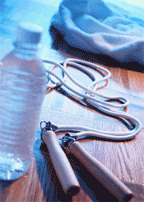If
a Repetitive Strain Injury (RSI) arises before prevention
techniques are implemented, it is important to
eliminate the injury / disorder as quickly as possible
in order to prevent the injury from becoming chronic,
which can cause scar tissue buildup, reduced blood
flow to surrounding soft tissues and possibly long-term
nerve damage. Once an injury occurs, ergonomic programs,
ergonomic tools / devices, stretch and exercise programs,
rehabilitation / therapeutic products and others are
all very important in the rehabilitation process.
 |
Fitness Programs are Key
to RSI Recovery |
The Rehabilitation Process
should really be approached as the "Elimination Process".
This is the process where the "elimination" of the
injury and the events leading up to the injury are
recognized and dealt with. If individuals are using
improper tools, holding devices incorrectly, have misaligned
computer monitors are using inadequate seating, not
taking breaks and not performing required stretches
and exercises throughout the day, these issues need
to be immediately addressed and corrected.
"Each year thousands
of people are diagnosed with some kind of an illness
directly related to poorly designed work stations.
In the U.S., Repetitive Strain Injury (RSI, for short)
has become the number one work-related health problem,
according to OSHA statistics."
"Ergonomic disorders are the fastest
growing category of work-related illness. According
to the most recent statistics from the U.S. Bureau
of Labor Statistics , they account for 56 percent of
illnesses reported to the Occupational Safety and Health
Administration (OSHA) ."
If it is too late to prevent the repetitive
strain injury from occurring, it is time to treat the
existing injury and implement injury prevention protocols
to reduce the chances of it from happening
again.
Job/Task Rotation (As
Part of the Rehabilitation Process)
Job rotation can help reduce the amount of stress to an already injured area,
helping the individual to recover in a more timely manner. At this level of
the treatment, the tasks must engage different muscle groups than those that
are injured in order to allow recovery. Be
sure that each task takes not longer than 30-minutes before moving to another
task.
Workstation Design (As
Part of the Rehabilitation Process)
If proper ergonomic equipment
or workstation set up has not
already ben established, now
is the time to do it. Again,
the key is to fit the workplace
to the worker, not the worker
to the workplace in order to
reduce the exacerbation of
the existing repetitive strain
injury. If the individual has
a wrist injury and it hurts
to use the computer mouse,
find other alternatives such
as voice recognition software,
self-clicking devices, etc.
to reduce unnecessary stresses.
Tools / Devices (As
Part of the Rehabilitation Process)
For rehabilitation purposes, the use of ergonomic tools and equipment is very
important as they can decrease the amount of force used for any specific task,
which reduces the chance of further irritating the existing repetitive strain
injury.
|
Conservative
Therapy - Solution to Recovery |
Work Habits (As
Part of the Rehabilitation Process)
This is the most important part
of the treatment process. Taking rest
breaks every 30-minutes and performing a good stretch
and exercise program 2-3 times daily (Morning, Noon and
Evening) is extremely important to keep the overused
and underused muscles of the upper extremity balanced.
The solution to rehabilitating exisitng
injureis is taking breaks and performing injury-specific
stretch and exercise programs that focus on strengthening
weak injured tendons and muscles and stretching overly
tight, restrictive muscles in order to maintain / increase
circulation whicih in turn brings oxygenated blood
to the muscles. These are key elements to recovering
from a repetitive strain injury. Without these elements,
the individual will most likely continue to experience
the injury, eventually causing it to become a chronic
long-term disorder.
|

